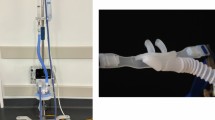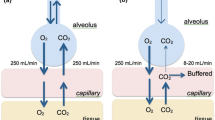Abstract
Transnasal humidified rapid insufflation ventilatory exchange (THRIVE) is a recent technique that delivers warm humidified high flow oxygen to patients, allowing for prolonged apneic oxygenation. A review of current literature was performed to determine the use of THRIVE in apneic patients undergoing surgery in a shared airway setting. An initial free hand search was done to identify keywords followed by a systematic search of major databases with no date or language restrictions. Inclusion criteria include all apneic patients who receive THRIVE for any operative procedure. Fifteen studies fulfilled the inclusion criteria. There were ten case series, two case reports, two review articles and one randomized controlled trial. All of the studies discussed the use of THRIVE during laryngopharyngeal surgeries. The median apnea time reported ranged between 13 and 27 min. There were no significant complications reported as a result of using THRIVE. Most studies identified in this review were observational in nature involving laryngopharyngeal procedures. They have demonstrated THRIVE to be effective in providing apneic oxygenation during short procedures in adult patients. Further studies are required to determine the limitations of safe use in specific populations and when THRIVE is combined with diathermy or laser use.

Similar content being viewed by others
References
Mir F, Patel A, Iqbal R, Cecconi M, Nouraei SA. A randomised controlled trial comparing transnasal humidified rapid insufflation ventilatory exchange (THRIVE) pre-oxygenation with facemask pre-oxygenation in patients undergoing rapid sequence induction of anaesthesia. Anaesthesia. 2017;72(4):439–43.
Helviz Y, Einav S. A systematic review of the high-flow nasal cannula for adult patients. Crit Care. 2018;22(1):71.
Patel A, Nouraei SA. Transnasal humidified rapid-insufflation ventilatory exchange (THRIVE): a physiological method of increasing apnoea time in patients with difficult airways. Anaesthesia. 2015;70(3):323–9.
Moller W, Celik G, Feng S, Bartenstein P, Meyer G, Oliver E, Schmid O, Tatkov S. Nasal high flow clears anatomical dead space in upper airway models. J Appl Physiol (1985). 2015;118(12):1525–32.
Rudlof B, Hohenhorst W. Use of apneic oxygenation for the performance of pan-endoscopy. Otolaryngol Head Neck Surg. 2013;149(2):235–9.
Gustafsson IM, Lodenius A, Tunelli J, Ullman J, Jonsson Fagerlund M. Apnoeic oxygenation in adults under general anaesthesia using transnasal humidified rapid-insufflation ventilatory exchange (THRIVE)—a physiological study. Br J Anaesth. 2017;118(4):610–7.
Parke RL, Bloch A, McGuinness SP. Effect of very-high-flow nasal therapy on airway pressure and end-expiratory lung impedance in healthy volunteers. Respir Care. 2015;60(10):1397–403.
Munn Z, Peters MDJ, Stern C, Tufanaru C, McArthur A, Aromataris E. Systematic review or scoping review? Guidance for authors when choosing between a systematic or scoping review approach. BMC Med Res Methodol. 2018;18(1):143.
Arksey H, O’Malley L. Scoping studies: towards a methodological framework. Int J Soc Res Methodol. 2005;8(1):19–32.
Lyons C, Callaghan M. Apnoeic oxygenation with high-flow nasal oxygen for laryngeal surgery: a case series. Anaesthesia. 2017;72(11):1379–87.
Valdinger S, Norris A, Rollason C, Sycamore H, Evans D. Transnasal humidified rapid-insufflation ventilatory exchange in ENT surgery: a case series. Anaesthesia. 2017;72:76.
Margarson M. Nasal high flow oxygen therapy: what the anaesthetist should know. J Clin Monit Comput. 2017;31(3):498.
Davies S, Vaidya A, Shankar R, Patel S. When plan A fails. Anaesthesia. 2018;73:41.
Lee SJ, Quek KH. Facilitating airway surgery in a morbidly obese patient using transnasal humidified rapid insufflation ventilatory exchange (THRIVE). Case Rep Anesthesiol. 2018;2018:5310342.
Kotwinski D, Paton L, Langford R. The role of high flow nasal oxygen therapy in anaesthesia. Br J Hosp Med (Lond). 2018;79(11):620–7.
Ridgway R, Dumbarton T, Brown Z. Update on ENT anaesthesia in children. Anaesth Intensive Care Med. 2019;20(1):56–60.
To K, Harding F, Scott M, Milligan P, Nixon IJ, Adamson R, McNarry AF. The use of transnasal humidified rapid-insufflation ventilatory exchange in 17 cases of subglottic stenosis. Clin Otolaryngol. 2017;42(6):1407–10.
Tam K, Jeffery C, Sung CK. Surgical management of supraglottic stenosis using intubationless optiflow. Ann Otol Rhinol Laryngol. 2017;126(9):669–72.
Yang S-H, Wu C-Y, Tseng W-H, Cherng W-Y, Hsiao T-Y, Cheng Y-J, Chan KC. Nonintubated laryngomicrosurgery with transnasal humidified rapid-insufflation ventilatory exchange: a case series. J Formos Med Assoc. 2019;118:1138–43.
Maupeu L, Raguin T, Hengen M, Diemunsch P, Schultz P. Indications of transnasal humidified rapid-insufflation ventilatory exchange (THRIVE) in laryngoscopy, a prospective study of 19 cases. Clin Otolaryngol. 2019;44:182–6.
Rajan S, Joseph N, Tosh P, Kadapamannil D, Paul J, Kumar L. Effectiveness of transnasal humidified rapid-insufflation ventilatory exchange versus traditional preoxygenation followed by apnoeic oxygenation in delaying desaturation during apnoea: a preliminary study. Indian J Anaesth. 2018;62(3):202–7.
Lau J, Loizou P, Riffat F, Stokan M, Palme CE. The use of THRIVE in otolaryngology: our experiences in two Australian tertiary facilities. Aust J Otolaryngol. 2019;2:22.
Huang L, Athanasiadis T, Woods C, Dharmawardana N, Ooi EH. The use of transnasal humidified rapid insufflation ventilatory exchange in laryngeal and pharyngeal surgery: Flinders case series. Aust J Otolaryngol. 2019;2:17.
Waters E, Kellner M, Milligan P, Adamson RM, Nixon IJ, McNarry AF. The use of transnasal humidified rapid-insufflation ventilatory exchange (THRIVE) in one hundred and five upper airway endoscopies. A case series. Clin Otolaryngol. 2019. https://doi.org/10.1111/coa.13408.
Ebeling CG, Riccio CA. Apneic oxygenation with high-flow nasal cannula and transcutaneous carbon dioxide monitoring during airway surgery: a case series. A&A Pract. 2019;12:366–8.
Ritchie JE, Williams AB, Gerard C, Hockey H. Evaluation of a humidified nasal high-flow oxygen system, using oxygraphy, capnography and measurement of upper airway pressures. Anaesth Intensive Care. 2011;39(6):1103–10.
Onwochei D, El-Boghdadly K, Oakley R, Ahmad I. Intra-oral ignition of monopolar diathermy during transnasal humidified rapid-insufflation ventilatory exchange (THRIVE). Anaesthesia. 2017;72(6):781–3.
Stuermer KJ, Ayachi S, Gostian AO, Beutner D, Huttenbrink KB. Hazard of CO(2) laser-induced airway fire in laryngeal surgery: experimental data of contributing factors. Eur Arch Otorhinolaryngol. 2013;270(10):2701–7.
Santos P, Ayuso A, Luis M, Martinez G, Sala X. Airway ignition during CO2 laser laryngeal surgery and high frequency jet ventilation. Eur J Anaesthesiol. 2000;17(3):204–7.
Casey KR, Fairfax WR, Smith SJ, Dixon JA. Intratracheal fire ignited by the Nd-YAG laser during treatment of tracheal stenosis. Chest. 1983;84(3):295–6.
Eger EI, Severinghaus JW. The rate of rise of PaCO2 in the apneic anesthetized patient. Anesthesiology. 1961;22:419–25.
Stock MC, Schisler JQ, McSweeney TD. The PaCO2 rate of rise in anesthetized patients with airway obstruction. J Clin Anesth. 1989;1(5):328–32.
Jooste KH. Anaesthesia in bronchography; endotracheal insufflation of oxygen during apnoea. Anaesthesia. 1955;10(1):59–66.
O’Croinin D, Ni Chonghaile M, Higgins B, Laffey JG. Bench-to-bedside review: permissive hypercapnia. Crit Care. 2005;9(1):51–9.
Bautista AF, Akca O. Hypercapnia: is it protective in lung injury? Med Gas Res. 2013;3(1):23.
Riva T, Pedersen TH, Seiler S, Kasper N, Theiler L, Greif R, Kleine-Brueggeney M. Transnasal humidified rapid insufflation ventilatory exchange for oxygenation of children during apnoea: a prospective randomised controlled trial. Br J Anaesth. 2018;120(3):592–9.
Riva T, Theiler L, Jaquet Y, Giger R, Nisa L. Early experience with high-flow nasal oxygen therapy (HFNOT) in pediatric endoscopic airway surgery. Int J Pediatr Otorhinolaryngol. 2018;108:151–4.
Riva T, Seiler S, Stucki F, Greif R, Theiler L. High-flow nasal cannula therapy and apnea time in laryngeal surgery. Paediatr Anaesth. 2016;26(12):1206–8.
Humphreys S, Rosen D, Housden T, Taylor J, Schibler A. Nasal high-flow oxygen delivery in children with abnormal airways. Paediatr Anaesth. 2017;27(6):616–20.
Caruso TJ, Gupta A, Sidell DR, Darling C, Rodriguez S, Fonseca A, Tsui B. The successful application of high flow nasal oxygen during microdirect laryngoscopy and bronchoscopy in patients under 7 kg. J Clin Anesth. 2019;52:27–8.
Gormley S, Crean P. Basic principles of anaesthesia for neonates and infants. BJA Educ. 2001;1(5):130–3.
Fraioli RL, Sheffer LA, Steffenson JL. Pulmonary and cardiovascular effects of apneic oxygenation in man. Anesthesiology. 1973;39(6):588–96.
Don HF, Wahba M, Cuadrado L, Kelkar K. The effects of anesthesia and 100 per cent oxygen on the functional residual capacity of the lungs. Anesthesiology. 1970;32(6):521–9.
Berthoud MC, Peacock JE, Reilly CS. Effectiveness of preoxygenation in morbidly obese patients. Br J Anaesth. 1991;67(4):464–6.
Booth AWG, Vidhani K, Lee PK, Thomsett CM. SponTaneous Respiration using IntraVEnous anaesthesia and Hi-flow nasal oxygen (STRIVE Hi) maintains oxygenation and airway patency during management of the obstructed airway: an observational study. Br J Anaesth. 2017;118(3):444–51.
Wang ML, Hung MH, Chen JS, Hsu HH, Cheng YJ. Nasal high-flow oxygen therapy improves arterial oxygenation during one-lung ventilation in non-intubated thoracoscopic surgery. Eur J Cardio-Thorac Surg. 2018;53(5):1001–6.
Author information
Authors and Affiliations
Corresponding author
Ethics declarations
Conflict of interest
There is no conflict of interest to declare.
Ethical approval
Ethical approval is not required as this is a narrative review.
Additional information
Publisher's Note
Springer Nature remains neutral with regard to jurisdictional claims in published maps and institutional affiliations.
Electronic supplementary material
Below is the link to the electronic supplementary material.
About this article
Cite this article
Huang, L., Dharmawardana, N., Badenoch, A. et al. A review of the use of transnasal humidified rapid insufflation ventilatory exchange for patients undergoing surgery in the shared airway setting. J Anesth 34, 134–143 (2020). https://doi.org/10.1007/s00540-019-02697-3
Received:
Accepted:
Published:
Issue Date:
DOI: https://doi.org/10.1007/s00540-019-02697-3




